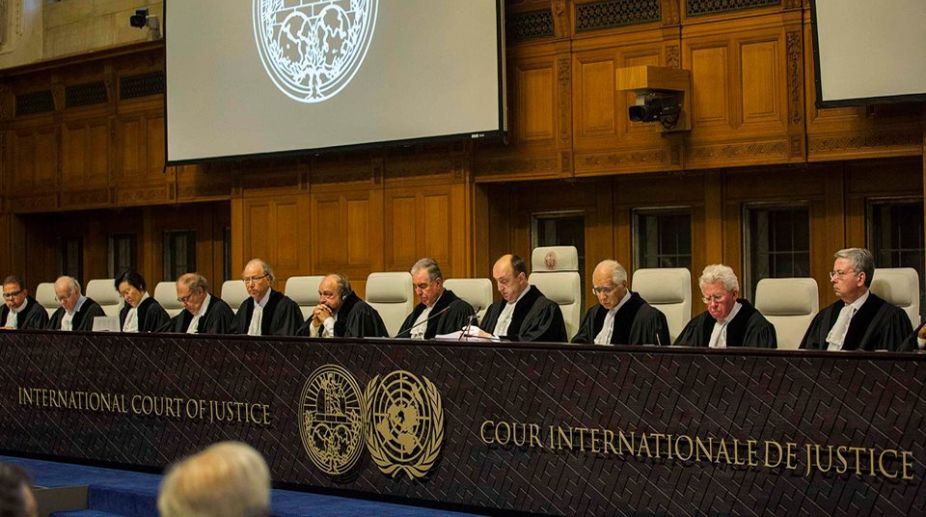As early as in 1962 the International Court of Justice in the Case Concerning the Temple of Preah Vihear (Cambodia v.Thailand), Merits (1962)declared: ‘When two countries establish a frontier between them, one of the primary objects is to achieve stability and finality. This is impossible if the line so established can, at any moment, and on the basis of a continuously available process, be called in question, and its rectification claimed, whenever any inaccuracy by reference to a clause in the parent treaty is discovered.
Such a process could continue indefinitely, and finality would never be reached so long as possible errors still remained to be discovered. Such a frontier, so far from being stable, would be completely precarious.’ Territorial disputes are common in the international sphere. Numerous boundary disputes continuously threaten international peace and security. Very long frontiers like Indo-China cause more uncertainty and friction. The recent Doklam standoff between India and China is a glaring instance of such trouble. The ICJ has been asked numerous times by warring states to decide on such contentious issues.
While deciding such cases the world court has utilised many principles of customary international law as well as interpretation of treaty provisions. It is a well settled law that a Court or Commission will interpret a treaty in good faith in accordance with the ordinary meaning to be given to the terms of the treaty in its context and in the light of its object and purpose. What is to be inferred is what the Parties actually intended or what was their common will [Palena award, Argentina/Chile Frontier Case (1966)]. While interpreting Treaties, the doctrine of “contemporaneity” which means that a treaty should be interpreted by reference to the circumstances prevailing when the treaty was concluded is also applied.
It includes giving expressions used in the treaty the meaning that they would have possessed at that time [Decision regarding delimitation of the border, EritreaEthiopia Boundary Commission (2002)]. But in the Case concerning Kasikili/Sedudu Island (Botswana/ Namibia), ICJ (1999), the world court held that for understanding the meaning of words used in the treaty it can take into account the present day state of scientific knowledge.
In the Palena case (1966) it was observed that it was proper to apply stricter rules to the interpretation of an Award determined by an Arbitrator than to a treaty which results from negotiation between two or more Parties, where the process of interpretation may involve endeavouring to ascertain the common will of those Parties.
Thus for the interpretation of treaty provisions, the common will in preparatory documents or even in subsequent action of the Parties can be considered. Very often in a case submitted to the court, the parties by mutual agreement ask the court that the decision be made “on the basis of the Treaty and the relevant principles of international law.”
The ICJ in the Kasikili/Sedudu Island case held that the words “and the relevant principles of international law” are not limited in their effect to the international law applicable to the interpretation of treaties but they also require the Court to take into consideration any rules of customary international law that might have a bearing on the case, for example, prescription and acquiescence even if such rules might involve a departure from the position prescribed by the relevant treaty provisions.
Thus the Court accepted the possibility that an attribution of territory following from its interpretation of the relevant boundary treaty could be varied by operation of the customary international law rules relating to prescription. Again in the Decision regarding delimitation of the border (EritreaEthiopia Boundary Commission) (2002), the Commission held that it was not bound to determine the boundary exclusively on the basis of the Treaties as interpreted in accordance with the rules of international law governing treaty interpretation and further held that it could apply the rules of international law applicable generally to the determination of disputed borders including the rules relating to the effect of conduct of the warring parties. The role of the subsequent practice or conduct of the Parties is also very relevant.
Such conduct may affect the legal relations of the Parties. But the Permanent Court of International Justice has qualified in The Serbian Loans case (1929) that such subsequent conduct of the Parties should not be considered to ascertain the terms of the contract, but to ascertain whether by their conduct they have altered or impaired their rights.
Now the conduct of the Parties can be activity on the ground tending to show the exercise of sovereign authority by the Party engaging in that activity (known as effectivités), maps and diplomatic and other similar exchanges and records constituting assertions of sovereignty, or acquiescence in or opposition to such assertions, by the other Party.
In the famous Temple of Preah Vihar case (ICJ, 1962), a case dealing with territorial sovereignty, Cambodia alleged a violation on the part of Thailand of Cambodia’s territorial sovereignty over the region of the Temple of Preah Vihear whereas Thailand contended that it was located on its side of the frontier between the two countries.
A map had been invoked on which a line had been drawn purporting to represent the frontier determined by a delimitation commission under a treaty which provided that the frontier should follow a watershed but in fact the line drawn did not follow the watershed. The Court based its decision upholding the “map line” on the fact that both Parties, by their conduct, recognized the line and thereby in effect agreed to regard it as being the frontier.
Also the visit paid to the Temple in 1930 by the Thai Prince who was formerly Minister of the Interior had a quasi-official character when he was officially received there by the French Resident for the adjoining Cambodian province with the French flag flying was held as tacit recognition by Thailand of the sovereignty of Cambodia (as a French Protectorate) over Preah Vihear.
Maps which are made authoritative by being annexed to a treaty as a definitive illustration of a boundary delimited by the treaty, are in a special category, since they “fall into the category of physical expressions of the will of the State or States concerned”[Case concerning the Frontier Dispute (Burkina Faso v. Mali), ICJ, 1986].
A map which is a part of a treaty has undoubtedly a very high value as it shares the legal quality of the treaty and is binding on the parties. But a map which is not a part of a treaty has different effects and it varies according to its provenance, its scale and cartographic quality, its consistency with other maps, the use made of it by the parties, the degree of publicity accorded to it and the extent to which, if at all, it was adopted or acquiesced in by the parties adversely affected by it, or the extent to which it is contrary to the interests of the party that produced it.
Again a map which has been used in negotiations during treaty making can assume certain significance. Even disclaimers do not automatically deprive a map of all evidential value. The boundary commission of Eritrea-Ethiopia in the Decision regarding delimitation of the border (2002) observed that as to activity on the ground the actions of a State pursued à titre de souverain (under the authority of the Sovereign) can play a role, either as assertive of that State’s position or, expressly or impliedly, contradictory of the conduct of the opposing State. It can be either legislative, administrative or judicial assertions of authority over the disputed area, but there need not be any set standard of duration and intensity of such activity.
The effect would depend on the nature of the terrain and the extent of its population, the period during which it has been carried on and the extent of any contradictory conduct (including protests) of the opposing State. Such conduct does not by itself produce an absolute and indefeasible title, but only a title relative to that of the competing State. The conduct of one Party must be measured against that of the other.
The legal result may be to vary a boundary established by treaty. The legal question of whether effectivités suggest that title lies with one country rather than another is not the same legal question as whether such effectivités can serve to displace an established treaty title.
Where there is a conflict between title and effectivités preference is given to the former [Frontier Dispute (Burkina Faso v. Republic of Mali)(1986)]. As the erstwhile Permanent Court of International Justice pithily observed in Acquisition of Polish Nationality, Advisory Opinion (1923) where a clause leaves little to be desired in the nature of clearness the Court is bound to apply the clause as it stands, without considering whether other provisions might with advantage have been added to or substituted for it.
A boundary established by treaty achieves a permanence which the treaty itself does not necessarily enjoy and hence a treaty can cease to be in force without in any way affecting the continuance of the boundary. Even though the two States may by mutual agreement vary the border between them but when a boundary has been the subject of agreement, the continued existence of that boundary is not dependent upon the continuing life of the treaty under which the boundary is agreed. The principle of uti possidetis juris is also very important in international law, the application of which gives rise to respect for intangibility of frontiers.
It was first applied in Spanish America when after decolonisation, a large number of sovereign States came into existence on territory formerly belonging to a single State. This principle primarily prevents the independence and stability of new States being endangered by fratricidal struggles provoked by the challenging of frontiers following the withdrawal of the administering power. It accords pre-eminence to legal title over effective possession as a basis of sovereignty. The essence of the principle lies in its primary aim of securing respect for the territorial boundaries at the moment when independence is achieved.
The application of the principle of uti possidetis resulted in administrative boundaries being transformed into international frontiers in the full sense of the term. Where the relevant administrative boundary was ill-defined or its position disputed, the behaviour of the two newly independent States in the years following independence may well serve as a guide to where the boundary was, either in their shared view, or in the view acted on by one and acquiesced in by the other.
Third parties may also be allowed to join the proceedings in such type of territorial disputes. The ICJ in Application for Permission to Intervene, Land, Island and Maritime Frontier Dispute (El Salvador/Honduras: Nicaragua intervening)(1990) for the first time permitted a third State to intervene. It further gave some indication of the procedural rights acquired by the intervening State as a result of that permission.
It held that the third state would not, as intervening State, become party to the proceedings and thus the third party would not be bound by the Judgment. There have been instances where two or more sovereign states equally exercise sovereignty with respect to a territory and its inhabitants. Such an agreement is known as Condominium.
Gulf of Fonseca is such an example providing for co-ownership of three coastal states of Nicaragua, El Salvador and Honduras. Similarly a series of English and French agreements established a condominium in the case of New Hebrides (now Republic of Vanuatu).
Though the court or commission can only resolve the boundary or territorial disputes brought before it, it is apposite to repeat the observation of the ICJ in the Case Concerning The Territorial Dispute (Libyan Arab Jamahiriya/Chad)(1994) that the fixing of a frontier depends on the will of the sovereign States directly concerned and there is nothing to prevent the parties from deciding by mutual agreement to consider a certain line as a frontier, whatever the previous status of that line.
If it was already a territorial boundary, it is confirmed purely and simply and if not the agreement of the parties to “recognize” it as such invests it with a legal force which it had previously lacked.
(The writers are Mumbai-based advocates and legal consultants.)I











